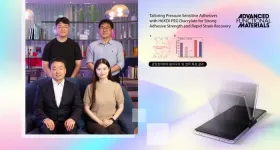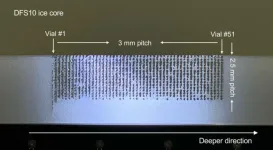Scientists are looking to plant tissues that are capable of motion to inspire the design and fabrication of artificial actuators. These bioinspired actuators hold significant potential in applications, such as soft robotics, prosthetics, and smart biomedical devices. A research team from the Chinese Academy of Sciences has published a perspective paper focusing specifically on the ways plants regulate their motion speed and how this might be applied with artificial actuators.
Their paper is published in the journal Nano Research on September 18.
These artificial actuators, that are responsive to humidity, solvents, heat, light, and electricity, convert the environmental energy into shape transformation. Scientists look to plants for inspiration because of the ways plants have learned to move.
Over billions of years of evolution, many plant organs have developed strategies for changing their shape. Plants use their shape changes to get nutrition, disperse seeds, bury seeds in soil, or even get rid of stress. “By drawing inspiration from nature, artificial actuators can be developed with a wide range of motion speeds, from ultrafast to ultraslow. This opens up new possibilities for creating advanced robotics and devices,” said Feilong Zhang, a researcher at the Technical Institute of Physics and Chemistry, Chinese Academy of Sciences.
Venus flytraps close their lobes to capture insects when their trigger hairs are touched twice. The sundew plant curls its leaves over its prey. The Mimosa pudica plant closes its leaves to avoid water droplets on rainy days. Even some dead plant tissue can change shapes. For example, the pine cone scale, wheat awn, seed pods, ice plant seed capsules, and the bristles of dandelion seeds can all change their shape.
In living plants, the shape changes and movement are related to ion channels. However, the dead plant tissues demonstrate hygroscopic motions, that is, movements related to changes in moisture. Because of their unique structures and compositions, these dead plant tissues provide scientists with natural models for artificial actuators.
These plants are able to control their movements in very precise ways. For example, pine cones move very slowly to guarantee that they open only in a long-term dry environment, which allows wind and animals to disperse the seeds from the parent trees.
Conventional research has focused mainly on the ways that the plant tissues move, but little attention has been given to the speed regulation strategies. In the team’s perspective paper, they focused on understanding the speed regulation strategies used by plant tissues and proposing potential speed regulation strategies for biomimetic actuators.
The team summarized the strategies of nature for designing biomimetic actuators that can mimic the incredible speed, from ultrafast to ultraslow, and versatility of biological systems. Their paper explores the mechanisms responsible for the shape changes, along with strategies for controlling the speed of the motion. The team also looks at several models learned from plant prototypes for bioinspired artificial actuators, with different scenarios related to different speed requirements. They explore the challenges and opportunities in the development of artificial actuators. Finally, the team discusses potential strategies for speed regulation of actuators that might contribute to their further development.
The current bioinspired artificial actuators with extreme speeds – ultrafast or ultraslow – still lag far behind what scientists observe in nature. “Therefore, there are still many challenges and opportunities in exploring the mechanism of natural motile plant tissues with extreme speeds and developing biomimicking artificial actuators for extended applications,” said Zhang.
The team notes that new biotechnology, like the genome editing tool CRISPR-Cas9, may provide opportunities to combine genetics and biomechanics so that the plant motion mechanisms can be studied at all scales, from the plant scale down to the cellular and molecular scales. “Furthermore, with the development of new responsive materials and manufacturing technology, such as multi-component 3D printing technology, more complex and functional actuators are to be designed and fabricated for specific practical applications by drawing inspirations from plant species,” said Zhang.
Looking ahead, the team plans to further explore the design principles of biomimetic actuators and to refine their performance. “Our ultimate goal is to develop actuators that can replicate the complexity and efficiency of biological systems,” said Zhang.
The Chinese Academy of Sciences research team includes Man Yang, Feilong Zhang, and Shutao Wang from the Technical Institute of Physics and Chemistry. Zhang and Wang also work at the School of Future Technology.
This research is funded by the National Natural Science Foundation of China and the International Partnership Program of the Chinese Academy of Sciences.
##
About Nano Research
Nano Research is a peer-reviewed, international and interdisciplinary research journal, publishes all aspects of nano science and technology, featured in rapid review and fast publishing, sponsored by Tsinghua University and the Chinese Chemical Society. It offers readers an attractive mix of authoritative and comprehensive reviews and original cutting-edge research papers. After 15 years of development, it has become one of the most influential academic journals in the nano field. In 2023 InCites Journal Citation Reports, Nano Research has an Impact Factor of 9.9, the total cites reached 35645, ranking first in China's international academic journals, and the number of highly cited papers reached 194, ranked among the top 1.8% of 8769 academic journals.
About SciOpen
SciOpen is a professional open access resource for discovery of scientific and technical content published by the Tsinghua University Press and its publishing partners, providing the scholarly publishing community with innovative technology and market-leading capabilities. SciOpen provides end-to-end services across manuscript submission, peer review, content hosting, analytics, and identity management and expert advice to ensure each journal’s development by offering a range of options across all functions as Journal Layout, Production Services, Editorial Services, Marketing and Promotions, Online Functionality, etc. By digitalizing the publishing process, SciOpen widens the reach, deepens the impact, and accelerates the exchange of ideas.
END









